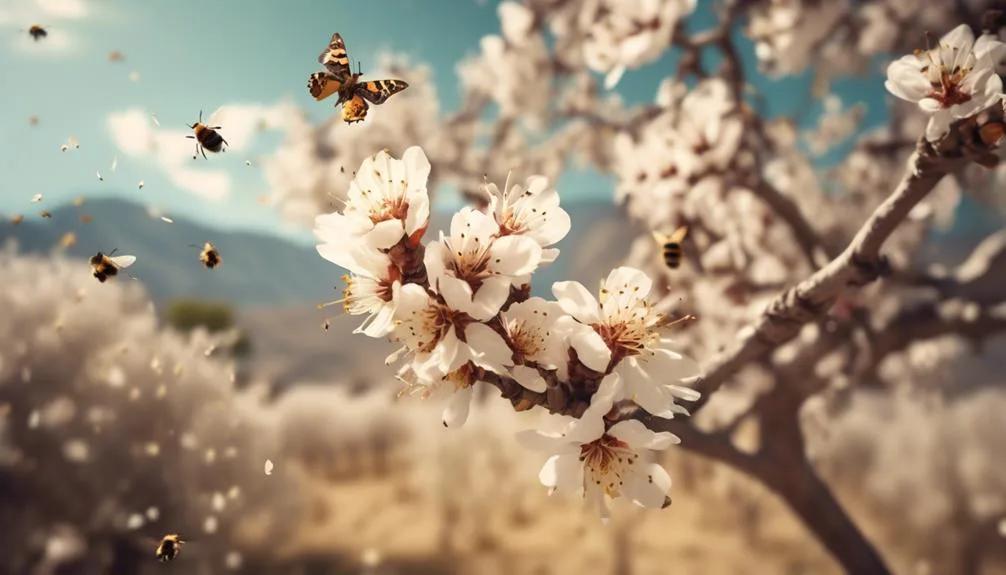Almond trees often make us wonder if they can pollinate themselves or need help from others. Understanding this is crucial for successful almond production.
Let's explore the world of almond tree pollination and uncover the factors at play.
Standing in an almond orchard, you might have asked yourself if these trees can pollinate on their own. This question holds the key to successful almond production, and it's an intriguing topic with various factors to consider.
Key Takeaways
- Almond tree bloom is a crucial stage in the pollination process, as flowers must be pollinated to produce almonds.
- Some almond tree varieties, such as 'Tuono' and 'All-In-One', are self-pollinating and can produce almonds without cross-pollination.
- Cross-pollination, facilitated by bees and wind, enhances fruit production, yield, and improves almond quality.
- To maximize almond tree pollination, planting different almond varieties in close proximity, diversifying varieties to extend the flowering period, and creating a pollinator-friendly environment are recommended.
Almond Tree Pollination Process
To ensure successful almond tree pollination, understanding the process is essential for maximizing yields and quality of the almonds.
Almond tree bloom is a crucial stage in the pollination process. The flowers must be pollinated to produce almonds. This is where the role of pollinator insects comes into play. Bees are the primary pollinators for almond trees. During the bloom, honeybees are brought in to transfer pollen from the male parts of the flower to the female parts. This process is vital for the development of the nut.
Without proper pollination, almond trees won't produce a good crop. Understanding the significance of pollinator insects and their role in almond tree bloom is crucial for successful almond production.
Factors Affecting Almond Tree Pollination
Factors that can affect almond tree pollination include weather conditions, availability of pollinator insects, and the proximity of almond orchards to natural habitats. Pollination challenges can arise from factors such as rain and wind, which can disrupt the pollination process by washing away pollen or preventing insects from flying. Environmental influences, including temperature and humidity, also play a crucial role in determining the success of pollination. Additionally, the availability of pollinator insects, such as bees, is essential for effective almond tree pollination. The proximity of almond orchards to natural habitats can impact the presence of pollinators and their ability to access the trees. Below is a table summarizing the factors affecting almond tree pollination:
| Factors | Impact |
|---|---|
| Weather conditions | Rain and wind can disrupt pollination |
| Pollinator insects | Availability of bees and other pollinators |
| Proximity to natural habitats | Impact on pollinator presence and access to trees |
Self-Pollinating Almond Tree Varieties
If you're looking to ensure successful almond tree pollination even without relying solely on external factors like weather and pollinator insects, exploring self-pollinating almond tree varieties is a promising avenue to consider.
Some self-pollinating almond varieties, such as 'Tuono' and 'All-In-One', have the capacity to produce almonds without requiring cross-pollination from other trees. This is advantageous as it reduces the dependence on outside factors for successful fruit set.
Additionally, when selecting self-pollinating almond varieties, it's crucial to consider their blossom timing. Varieties with overlapping bloom periods can enhance the likelihood of successful self-pollination, ensuring that the flowers are receptive when the pollen is available within the same tree.
Cross-Pollination in Almond Trees
Wondering how cross-pollination in almond trees can enhance fruit production and yield?
Cross-pollination involves the transfer of pollen from one almond tree variety to another. This process is essential for genetic diversity, which can lead to increased fruit set and improved crop yields.
Almond trees are typically cross-pollinated by bees, and sometimes by wind, which helps to ensure better fertilization. By planting different almond tree varieties in proximity to each other, you can encourage cross-pollination and maximize fruit production.
This technique not only enhances the overall yield but also improves the quality of the almonds. So, when planning your almond orchard, consider the benefits of cross-pollination and the role it plays in the pollination techniques and genetic diversity of almond trees.
Maximizing Almond Tree Pollination
To maximize almond tree pollination and ensure optimal fruit production, consider strategically planting different almond tree varieties in close proximity to one another. This enhances cross-pollination and significantly increases the chances of successful fertilization.
To further enhance almond yields, follow these pollinator friendly practices:
- Diversify Varieties: Plant a mix of early and late-blooming almond tree varieties to extend the flowering period and increase the overlap of pollination time.
- *Example*: Pair the Nonpareil variety with the Mission or Carmel variety to maximize cross-pollination.
- Attract Pollinators: Create a pollinator-friendly environment by incorporating flowering plants and providing nesting sites to attract bees and other pollinating insects.
Conclusion
In the end, while some almond tree varieties are self-pollinating, cross-pollination with other varieties can significantly boost fruit production. Factors like weather, bee activity, and tree density also impact successful pollination.
By selecting the right almond tree varieties and optimizing pollination conditions, you can increase your almond yield. Consider these factors and enjoy a thriving harvest.

